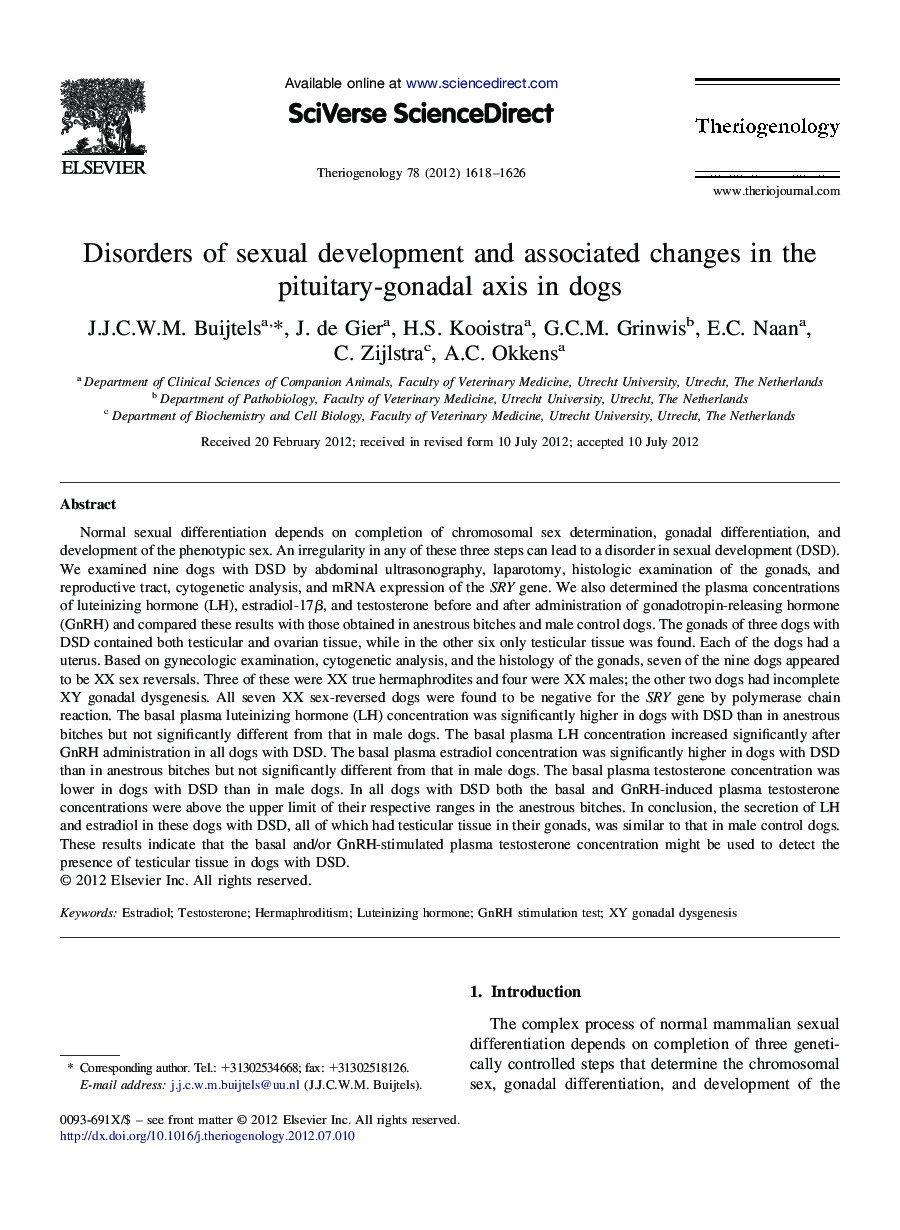| کد مقاله | کد نشریه | سال انتشار | مقاله انگلیسی | نسخه تمام متن |
|---|---|---|---|---|
| 10892653 | 1082111 | 2012 | 9 صفحه PDF | دانلود رایگان |
عنوان انگلیسی مقاله ISI
Disorders of sexual development and associated changes in the pituitary-gonadal axis in dogs
دانلود مقاله + سفارش ترجمه
دانلود مقاله ISI انگلیسی
رایگان برای ایرانیان
کلمات کلیدی
موضوعات مرتبط
علوم زیستی و بیوفناوری
علوم کشاورزی و بیولوژیک
علوم دامی و جانورشناسی
پیش نمایش صفحه اول مقاله

چکیده انگلیسی
Normal sexual differentiation depends on completion of chromosomal sex determination, gonadal differentiation, and development of the phenotypic sex. An irregularity in any of these three steps can lead to a disorder in sexual development (DSD). We examined nine dogs with DSD by abdominal ultrasonography, laparotomy, histologic examination of the gonads, and reproductive tract, cytogenetic analysis, and mRNA expression of the SRY gene. We also determined the plasma concentrations of luteinizing hormone (LH), estradiol-17β, and testosterone before and after administration of gonadotropin-releasing hormone (GnRH) and compared these results with those obtained in anestrous bitches and male control dogs. The gonads of three dogs with DSD contained both testicular and ovarian tissue, while in the other six only testicular tissue was found. Each of the dogs had a uterus. Based on gynecologic examination, cytogenetic analysis, and the histology of the gonads, seven of the nine dogs appeared to be XX sex reversals. Three of these were XX true hermaphrodites and four were XX males; the other two dogs had incomplete XY gonadal dysgenesis. All seven XX sex-reversed dogs were found to be negative for the SRY gene by polymerase chain reaction. The basal plasma luteinizing hormone (LH) concentration was significantly higher in dogs with DSD than in anestrous bitches but not significantly different from that in male dogs. The basal plasma LH concentration increased significantly after GnRH administration in all dogs with DSD. The basal plasma estradiol concentration was significantly higher in dogs with DSD than in anestrous bitches but not significantly different from that in male dogs. The basal plasma testosterone concentration was lower in dogs with DSD than in male dogs. In all dogs with DSD both the basal and GnRH-induced plasma testosterone concentrations were above the upper limit of their respective ranges in the anestrous bitches. In conclusion, the secretion of LH and estradiol in these dogs with DSD, all of which had testicular tissue in their gonads, was similar to that in male control dogs. These results indicate that the basal and/or GnRH-stimulated plasma testosterone concentration might be used to detect the presence of testicular tissue in dogs with DSD.
ناشر
Database: Elsevier - ScienceDirect (ساینس دایرکت)
Journal: Theriogenology - Volume 78, Issue 7, 15 October 2012, Pages 1618-1626
Journal: Theriogenology - Volume 78, Issue 7, 15 October 2012, Pages 1618-1626
نویسندگان
J.J.C.W.M. Buijtels, J. de Gier, H.S. Kooistra, G.C.M. Grinwis, E.C. Naan, C. Zijlstra, A.C. Okkens,